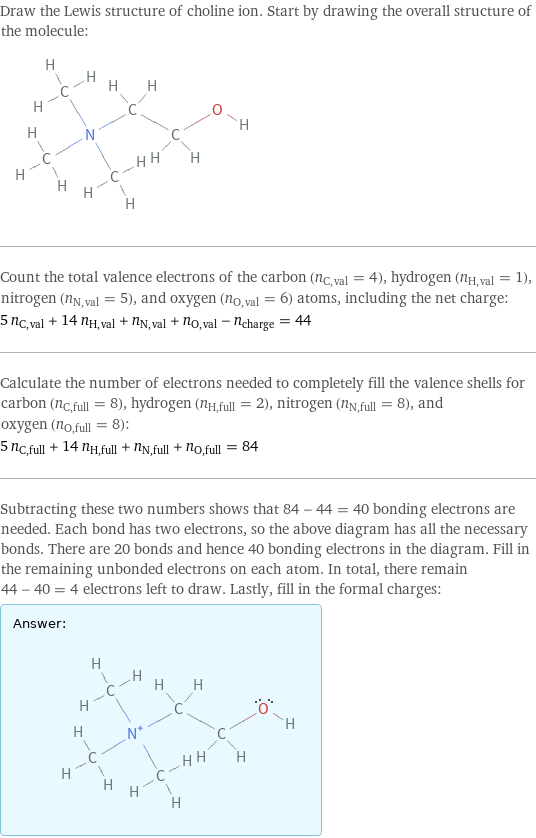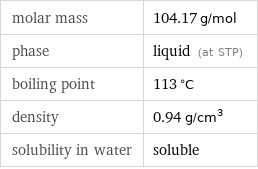Input interpretation

choline ion
Chemical names and formulas
![formula | [HOCH_2CH_2N(CH_3)_3]+1 Hill formula | C_5H_14NO+ name | choline ion IUPAC name | 2-hydroxyethyl-trimethyl-azanium alternate names | choline | ethanaminium, 2-hydroxy-N, N, N-trimethyl- mass fractions | C (carbon) 57.6% | H (hydrogen) 13.5% | N (nitrogen) 13.4% | O (oxygen) 15.4%](../image_source/81c79eaaebd16e29604df5a5cda14e84.png)
formula | [HOCH_2CH_2N(CH_3)_3]+1 Hill formula | C_5H_14NO+ name | choline ion IUPAC name | 2-hydroxyethyl-trimethyl-azanium alternate names | choline | ethanaminium, 2-hydroxy-N, N, N-trimethyl- mass fractions | C (carbon) 57.6% | H (hydrogen) 13.5% | N (nitrogen) 13.4% | O (oxygen) 15.4%
Lewis structure

Draw the Lewis structure of choline ion. Start by drawing the overall structure of the molecule: Count the total valence electrons of the carbon (n_C, val = 4), hydrogen (n_H, val = 1), nitrogen (n_N, val = 5), and oxygen (n_O, val = 6) atoms, including the net charge: 5 n_C, val + 14 n_H, val + n_N, val + n_O, val - n_charge = 44 Calculate the number of electrons needed to completely fill the valence shells for carbon (n_C, full = 8), hydrogen (n_H, full = 2), nitrogen (n_N, full = 8), and oxygen (n_O, full = 8): 5 n_C, full + 14 n_H, full + n_N, full + n_O, full = 84 Subtracting these two numbers shows that 84 - 44 = 40 bonding electrons are needed. Each bond has two electrons, so the above diagram has all the necessary bonds. There are 20 bonds and hence 40 bonding electrons in the diagram. Fill in the remaining unbonded electrons on each atom. In total, there remain 44 - 40 = 4 electrons left to draw. Lastly, fill in the formal charges: Answer: | |
3D structure

3D structure
Basic properties

molar mass | 104.17 g/mol phase | liquid (at STP) boiling point | 113 °C density | 0.94 g/cm^3 solubility in water | soluble
Units

Hydrophobicity and permeability properties

predicted LogP hydrophobicity | -3.59 predicted LogS | -1.59
Basic drug properties

approval status | approved | nutraceutical | small molecule drug categories | dietary supplement | lipotropic agent | micronutrient | nootropic agent dosage forms | oral: tablet
Liquid properties (at STP)

density | 0.94 g/cm^3
Units

Chemical identifiers
(C)CCO InChI identifier | InChI=1/C5H14NO/c1-6(2, 3)4-5-7/h7H, 4-5H2, 1-3H3/q+1 InChI key | OEYIOHPDSNJKLS-UHFFFAOYAN EU number | 200-535-1 RTECS number | FZ9625000 NSC number | 402838](../image_source/77183e93c274b8dd6798c55c2c46b25f.png)
CAS number | 62-49-7 Beilstein number | 1736748 PubChem CID number | 305 PubChem SID number | 149004 SMILES identifier | C[N+](C)(C)CCO InChI identifier | InChI=1/C5H14NO/c1-6(2, 3)4-5-7/h7H, 4-5H2, 1-3H3/q+1 InChI key | OEYIOHPDSNJKLS-UHFFFAOYAN EU number | 200-535-1 RTECS number | FZ9625000 NSC number | 402838
Safety properties

flash point | -33 °C autoignition point | 349 °C

DOT hazard class | 3 DOT numbers | 2924
Toxicity properties

RTECS classes | other